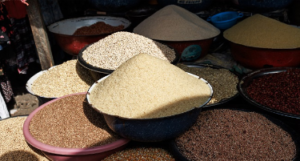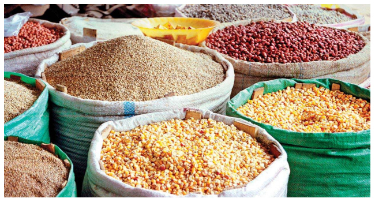The National Bureau of Statistics (NBS) has recently released a comprehensive report highlighting a significant increase in the prices of essential food items such as beans, tomatoes, Irish potatoes, garri, and yam in June 2024. This comes against the backdrop of a broader inflationary trend in the country.
Just days ago, the NBS announced that headline inflation for June 2024 had risen to 34.19 percent, up from 33.95 percent in May 2024. The newly released “Selected Food Prices Watch” report provides a detailed account of the price hikes experienced by Nigerian consumers.
One of the most striking findings is the increase in the average price of 1kg of brown beans, which soared by 252.13 percent, from ₦651.12 in June 2023 to ₦2,292.76 in June 2024. On a month-on-month basis, the price rose by 14.11 percent, up from ₦2,009.23 in May 2024. This substantial increase underscores the challenges facing both consumers and policymakers in addressing food affordability.
The report also highlighted a dramatic rise in the price of tomatoes. The average cost of 1kg of tomatoes jumped by 320.67 percent, from ₦547.28 in June 2023 to ₦2,302.26 in June 2024. Month-on-month, the price surged by 55.97 percent from ₦1,479.69 in May 2024. Such a steep increase in a staple item poses significant implications for household budgets across the country.
Similarly, the average price of 1kg of Irish potatoes saw a year-on-year increase of 288.50 percent, rising from ₦623.75 in June 2023 to ₦2,423.27 in June 2024. The price of white garri, another staple, rose by 181.66 percent, from ₦403.15 in June 2023 to ₦1,135.51 in June 2024. On a month-on-month basis, the price of white garri increased by 1.86 percent, up from ₦1,114.72 in May 2024.
The cost of yam tubers also experienced a significant hike. The average price of 1kg of yam tuber rose by 295.79 percent, from ₦510.77 in June 2023 to ₦2,021.55 in June 2024. This sharp rise reflects the broader trend of escalating food prices impacting Nigerian consumers.
A detailed state-by-state analysis reveals notable regional disparities in food prices. In June 2024, Kogi recorded the highest average price for 1kg of brown beans at ₦3,006.43, while the lowest price was recorded in Adamawa at ₦1,336.11. Abuja had the highest average price for 1kg of tomatoes at ₦3,992.61, whereas Kebbi had the lowest at ₦1,200. Lagos recorded the highest price for 1kg of yam tuber at ₦3,376.54, while Adamawa again had the lowest at ₦1,100.
 The report further highlighted that Gombe had the highest average price for 1kg of white garri at ₦1,619.27, with the lowest price reported in Taraba at ₦900. Zone-by-zone analysis indicated that the North-Central region had the highest average price for 1kg of brown beans at ₦2,923.45, followed by the South-South at ₦2,630.03.
The report further highlighted that Gombe had the highest average price for 1kg of white garri at ₦1,619.27, with the lowest price reported in Taraba at ₦900. Zone-by-zone analysis indicated that the North-Central region had the highest average price for 1kg of brown beans at ₦2,923.45, followed by the South-South at ₦2,630.03.
The South-West and South-East regions recorded the highest average prices for 1kg of tomatoes at ₦3,261.84 and ₦2,852.59, respectively, while the North-West had the lowest at ₦1,411.16. The South-West also had the highest average price for 1kg of yam tuber at ₦2,745.80, followed by the North-Central at ₦2,440.35, with the North-West recording the lowest at ₦1,238.49. The highest average price for 1kg of white garri was recorded in the South-West at ₦1,199.62, followed by the North-East at ₦1,155.63.
In response to the escalating food prices, the Federal Government has taken significant measures to address the situation. Recently, a 150-day duty-free import window was granted for essential food commodities, aimed at curbing the relentless increase in food prices and ensuring food security.
This suspension of duty tariffs and taxes applies to the importation of certain food items across land and sea borders, including maize, cowpeas, wheat, and husked brown rice. Additionally, the government has approved the distribution of some grains nationwide to alleviate the pressure on food supplies.
As Nigeria grapples with rising inflation and its impact on food prices, these measures by the government represent critical steps toward stabilizing the market and providing relief to consumers. However, the ongoing situation highlights the need for long-term strategies to enhance food production, distribution, and affordability in the country.




